A new standard in hell: The IS-2
As the escalation between German and Russian engineers reached a new point with the introduction on the German side of the Panther and Tiger, and the knowledge that something bigger was brewing, the IS-2 was pressed into introduction as soon as its main armament was ready. With a partly sloped frontal armor, 120 mm (4.72 in) thick and, moreover, a new massive 122 mm (4.8 in) main gun, the new heavy tank seemed to be just the trump card Stalin needed to wash over any armored opposition on the Eastern Front. Or so it seemed on paper. In reality, some shortcuts were taken to meet the expectations. These would prove real issues on the long run, starting with the gun itself, slow to reload and with bulky two-piece naval ammunition.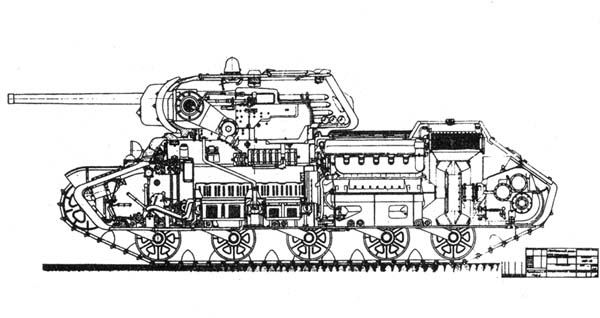
KV-13 prototype cutaway
Precursors: The IS-1 and IS-100
The IS-1 was an improvement over previous designs, combining the hull developed for the KV-13 prototypes with the new three-man KV-85 turret, fielding the new D5-T 85 mm (3.35 in) gun. The only issue with this gun was that the new medium T-34/85, which sported the same gun, was released in the meantime, entering service during the winter 1943/44. So the IS-1 had, like the former KV-1, only slightly better protection, but shorter range and poorer mobility compared to its medium counterpart. However, the roomy turret could manage heavier and better guns. As early as November and December 1943, tests were performed with a new gun, the 100 mm (3.94 in) BS-3 already tested on the new SU-100 tank-hunter. This resulted in the IS-100, two prototypes which went into trials against the IS-122 armed with the new A19 122 mm (4.8 in) gun. Though the IS-100 was reported to have better armor-piercing qualities, the latter had better all-around performance, and the IS-100 development was terminated.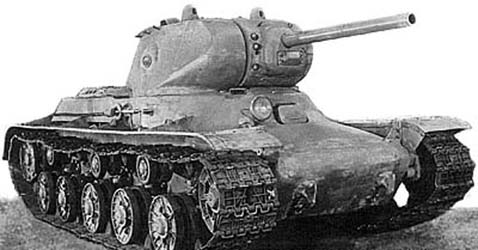 KV-13 prototype front view
KV-13 prototype front view
The IS-122
The choice of a new 122 mm (4.8 in) gun was studied by Kotin's team at Zavod Nr.9. As shown at Kursk, the 122 and 152 mm (5.98 in) guns were better suited to take on on the new German tanks, the Tiger, Panther and Elefant. It was obvious that, aside the 85 mm (3.35 in) gun, more suitable for the next evolution of the T-34, a 122 mm would be most recommended to be fitted on the new heavy tank. The adapted field gun A19 model 1937, designed by General A. A. Petrov, had a single chamber muzzle brake, was fitted with a recoil cradle and loading/lifting mechanism from the experimental U-11 and hybridized with a M-30 howitzer mount. Ballistic tests were performed between the A19 and BS-3 in October-November 1943, on a captured Panther.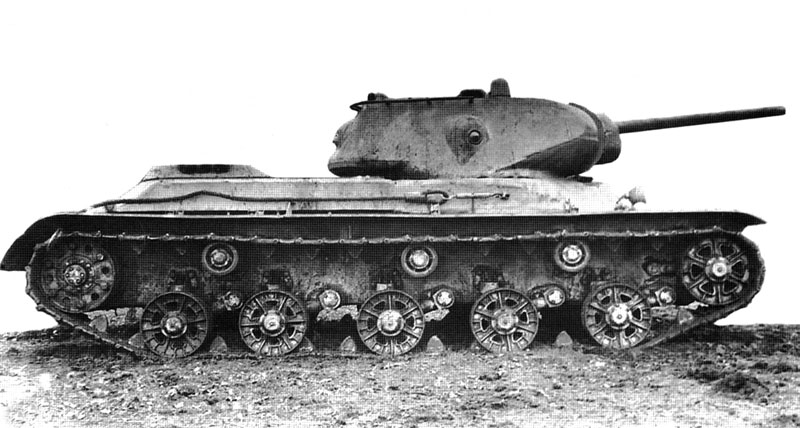
KV-13 prototype side view
This led to the acceptance of the 122 mm (4.8 in) by the HBTU, but also a modification of the muzzle brake with two chambers ("German type"), after almost fatally injuring Marshall Voroshilov during a test in the presence of the Main Defense Commissariat. The A19 still possessed features retained from the original gun, including the cumbersome two-part shell. This had two consequences. A trained crew could only fire two to three rounds a minute, while the ammo supply was limited to only 27 rounds. Nevertheless, the A19 had a better punch despite lower muzzle velocity compared to the 100 mm (3.94 in). It was believed the frontal armor would protect the tank until the target was within a 500 yards (460 m) range, where the heavy round could have its maximum impact. Around 102 to 107 IS-122s were delivered between December 1943 and February 1944, and the name was changed to IS-2.
The IS-2 model 1943
Armor
The first version of the IS-2 (production name) was equipped with the A19 gun, and production started in November 1943 at the Chelyabinsk factory. Initial proposals for the turret included a 152 mm (5.98 in) howitzer, a 50 mm (1.97 in) mortar capable of launching smoke shells or flares and, most importantly, a fully revolving commander cupola also serving a DSHT heavy machine gun. The latter was intended for AA defense and was finally accepted in the definitive production design. The second great innovative figure of the IS-2 was its new frontal armor, still stepped, but uniformly "blended", with 120 mm (4.72 in)/30° and 60 mm (2.36 in)/72° slope, offering better resistance while still saving weight. Thanks to this, the glacis could now withstand a 88 mm (3.46 in) AP shell at 1000 m (1100 yards). Because of the large recoil mechanism of the gun and a 1800 mm (70.86 in) turret ring radius, the internal space was cramped and only permitted a four-man crew, the commander having to command, order fire and make radio contact.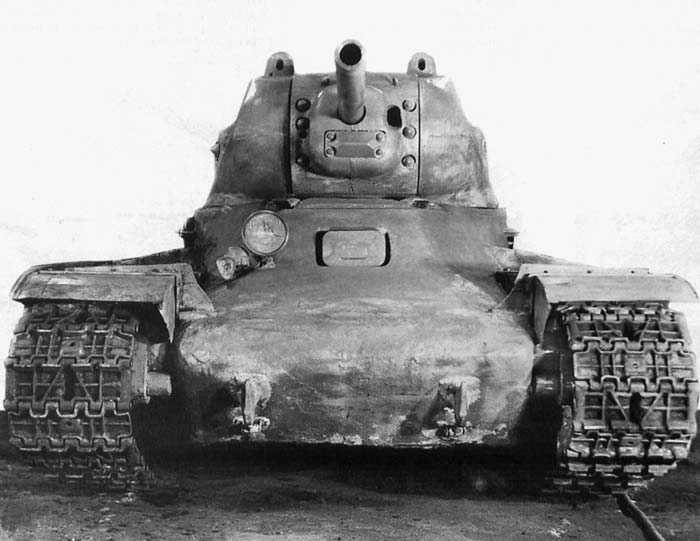
KV-13 prototype front view
Powerplant
The diesel engine was the V2-IC, basically the same already installed in the KV-1, with some antiquated features, but also some improvements. There was an inertial starter with manual and electric drives or compressed air which could be activated from the inside. The electric inertial starter was an auxiliary electric motor giving 0.88 kW. There was a NK-1 high pressure pump with variable speed master RNA-1 and leak proof fuel cells. Air filtering through the fighting compartment was obtained by using the engine to pump the air from inside, and there was a reverse for heating the crew in winter. The engine was given a warming device installed in the transmission unit, in order to start it when it was extremely cold. The engine was fed by three tanks, two into alongside fighting compartment and one at the rear, in the engine compartment unit. Four external tanks with a total capacity of 360 liters could be added as well, not a luxury since the near 50 ton vehicles were well-known "gas-guzzlers".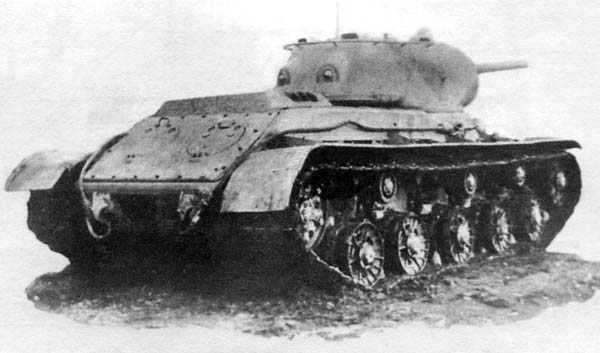
KV-13 prototype front view
Drivetrain
The drivetrain was identical to the one of KV-85 and very similar to that of the KV-1, with 6 double cast metal 550 mm (21.65 in) road wheels suspended by robust torsion arms on each side and three return rollers. The front idlers were of the same kind as the roadwheels to ease production, while the large dented rear drive sprockets were also unchanged since the beginning. The track was also consistent with previous models, counting 86 links, 650 mm (25.59 in) wide each. The transmission comprised a multi-disc main clutch dry friction "Ferodo steel", four-speed dual (8 forward and 2 reverse), but the second reverse gear was only available in theory, as it was never used in reality. There was a two stage planetary rotation mechanism with multi-locking "steel on steel" clutch dry friction and band brake, and two-lane combined board gear.Production
The bulk of the production started in February 1944, with around 2,252 delivered until the end of the year, perhaps 50% being of the new IS-2 1944 model. There was a subtle difference concerning the nose, between the one manufactured by Chelyabinsk (rounded cast) in August 1944, and the UZTM nose which had a flat lower bow plate. But as soon as they were put into service, alarming reports claimed that the limited ammo provision always meant supply had to be carried by following trucks, and the low rate of fire was almost half that of the T-34/85, while the latter had greater muzzle velocity.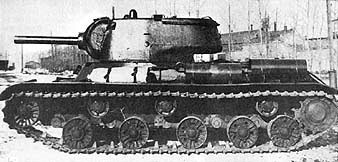
KV-13 prototype front view
A new gun was urgently needed. Plus, other reports showed that even the new armor-piercing shell BR-471 failed to penetrate the frontal armor of a Panther at less than 700 m (765 yards). Only the RP-471 HE rounds had a better chance in jamming the enemy turret, because the tremendous blast torn away the turret ring. Same effects could be devastating on the tracks. However, the situation tended to change in time because of the degrading quality of German steel armor plates, devoid of Manganese, as it was in short supply. The high carbon steel used instead was much more fragile.
The anti-aircraft DSHK heavy-machine gun was introduced on the final production IS-1. Its performances were relatively similar to the cal.50 in terms of penetration, rate of fire and reliability. The massive pintle mount was located just at the rear of the commander cupola, which itself could turn, acting as a ring mount.
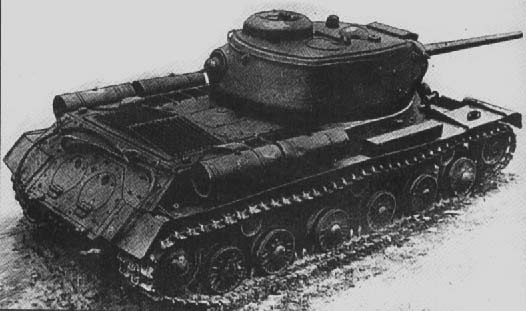
The IS-2 model 1944
By 1944, a new version of the 122 mm (4.8 in) gun, the D-25T, already tested in January on a single IS-122, was accepted in service to replace the A19. It had a 780-790 m/sec muzzle velocity (2600 ft/sec) and could penetrate 140 mm (5.51 in) of armor at 500 m (550 yards). But, most important, the breech mechanism, although still semi-automatic, was geared to sustain a reduced loading time. The design team also wanted a more protective turret, but the added armor would lead to an unbalanced design, thus forcing the redesign of many other parts of the tank. But since production was paramount the project was cancelled. The problems of internal glacis armor plate releasing fragments when hit was solved thanks to the experts of the CRI-48 tank builders, which developed a new form of armor plates, as well as improved the manufacturing technologies. The other important innovation was an uniformly sloped frontal glacis plate at angle of 60°, with 100 mm (3.94 in) of armor. According to some sources, 1,150 were built after May 1945 before the series was terminated in favor of the IS-3. The only variant known was a mine roller version deployed by a special Guards Battalion during the later phase of the assault on Berlin. Reliability also increased in time. The first IS-2s from the summer 1944 series were only guaranteed for a 1,000 km (621 mi) run. However, by 1945, the commander of the 1st Belorussian Front reported that "The heavy tanks worked well and exceeded the warranty period by 1.5 to 2 times, both in hours usage and by kilometrage".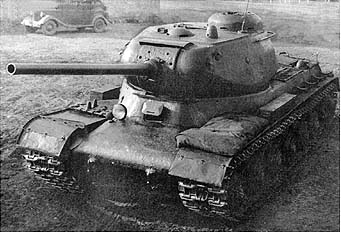
The IS-2M
Another version was experimentally built in the summer of 1944. It was a radical departure from the series, with the transmission and fighting compartments relocated to the rear, the engine in the center and driver and radio at the front. The chassis was reworked with a new drivetrain comprising larger doubled roadwheels and no return rollers. In the meantime, new prototypes were conceived, the IS-3, IS-4 and IS-5, which all had design flaws and saw limited production. Consequently, the confidence given to the battle-tested IS-2 by the supreme command of the Red Army was to push an extensive set of postwar modifications, first ratified in 1954 and applied in 1957, known as the upgraded "IS-2M". The range of modifications included an improved fire control system, extending the effective range of the 122 mm (4.72 in), a new prism sight slit for the driver and TVN-2 or NRZ night vision system. Also fitted were a new B-54K-IS engine, electric starter, new lubrication and cooling system, fuel injection heater NICS-1, electric pump MOHP-2 and a VTI-2 air cleaner with improved fire smoke extraction. There was also a new gearbox with oil pump and oil cooling system with a direct rigid attachment at the rear bearing. The planetary rotation mechanism was connected to the host drive final drive with semi-rigid connections. The return rollers were changed as well as the suspension bearings. Internal modifications inside the turret and enhanced recoil system components shared with the T-54 permitted to store 35 rounds. A modern R-113 radio set was also fitted. Externally, stowage bins over the tracks were added, as well as BDSH smoke bombs projectors.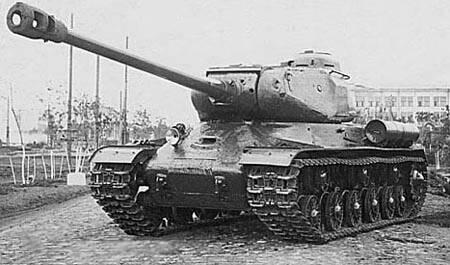
The IS-2 in action
Tactically, the IS-2s were deployed with the elite Guards Battalions, which acted on request wherever a strongpoint was encountered. Its capacity to destroy Panthers and Tigers, as well as fortifications with HE rounds, made it irreplaceable. A typical Guard Tank Brigade had 3 regiments of 65 IS-2s each. Independent Guard units also existed with fewer vehicles and with their supply train. Their first action was in February 1944 at Korsun Chevchenkovski, Ukraine. Later, a single unit of 10 IS-2s from the 72nd Regiment engaged and claimed to have destroyed no less than 41 Tigers and "Ferdinands" in several engagements between April and May 1944, claiming the loss of eight tanks. The frontal armor proved impervious to the 88 mm (3.46 in) at usual German firing distances of 1000 m (1093 yards) and more. The same regiment was later committed within the 18th Army to fight-off the General Stanislav's Axis-equipped Russian forces as part of the 4th Panzer Army.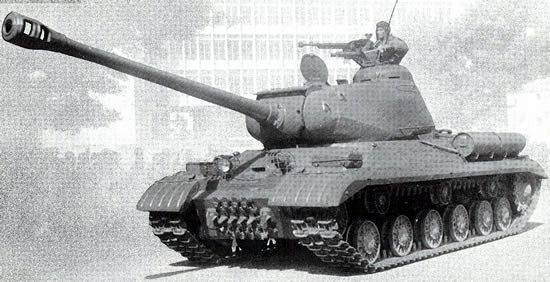
During one of these battles, near the settlement of Târgu Frumos, a single IS-2 was damaged and later examined by General Guderian himself, whom concluded that the "Stalin" was worth of its name. "Do not get involved in a fight with a "Stalin" without overwhelming numerical superiority in the field. I believe that for every "Stalin" we must account for an entire platoon of Tigers." Any attempts by a single "Tiger" to fight a "Stalin" one-on-one can only result in the loss of a priceless war machine." Soon, new tactical rules were devised to flank and surround IS-2s and get shots in its vulnerable sides, rear and the sensitive "shot trap" rear turret basket, and only at short range. Presumably German tactical superiority was again called for the task.
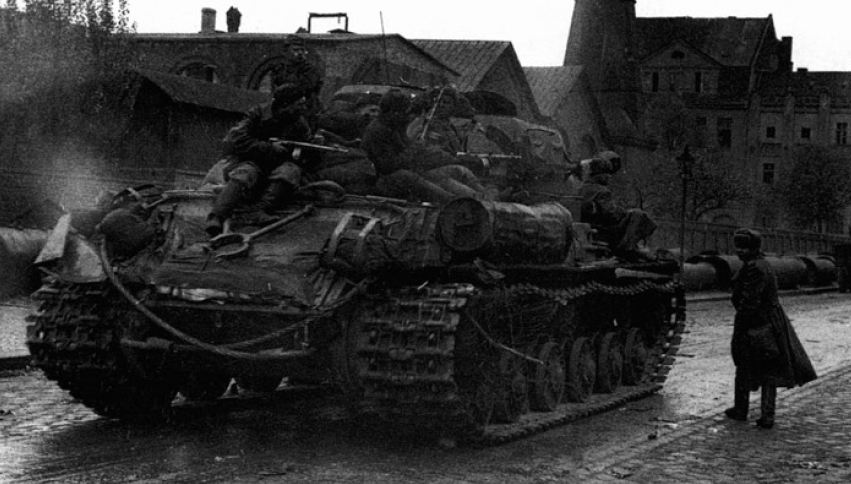
On the northern sector many IS-2s were also committed during operation Bagration, the summer 1944 offensive on eastern Germany. During the battle on the Sandomierz bridgehead, on August, 13, 1944, the Germans launched a powerful counter-attack led by brand-new heavy tanks. The battle lasted until the 31st of August, and the Russians, placed on well-prepared fortified defensive positions, claimed four Königstigers and seven damaged, three Panthers and even a giant Jagdtiger SPG. As it appeared later, the eleven IS-2s from the 71st Independent Heavy Tank Regiment had successfully repelled an assault from a total of fourteen Panzer VI Ausf. B Königstiger from the 501st Heavy Panzer Regiment. The battle raged at only 656 yards (600 m) and ended with three IS-2s destroyed and seven damaged.
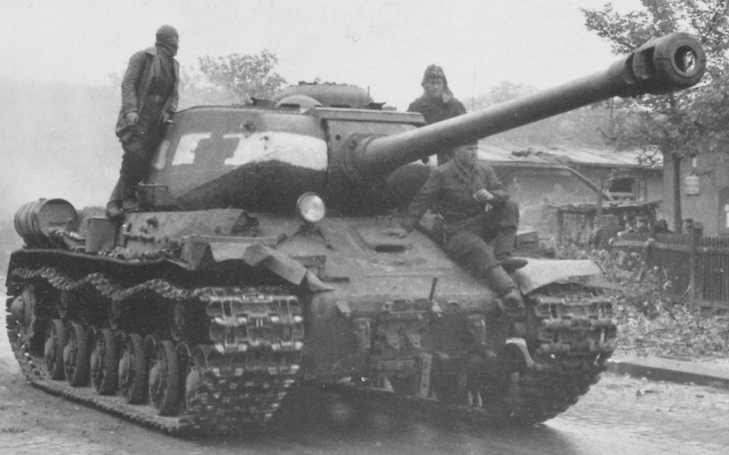 However, it appeared that the loading rate of the new D-25T was still around 20-30 seconds, during that time a Panther could still fire 6-7 rounds. Plus, the ammo was still cumbersome to use and always in short supply. Other battle honors included the Leningrad front, the Baltic states, with the liberation of Lithuania and Latvia, but the offensive ran short at Tallin, where the 36th Independent Guard Regiment lost three tanks and the remaining already worn-out tanks were damaged when attempting to reduce a series of fortifications. The harsh and marshy terrain of eastern Prussia was not friendly to heavy tanks, which had to deal with a well-prepared, deep defensive perimeter. The 79th Regiment suffered badly there until October, but it was more lucky at the battle of the Narew river.
However, it appeared that the loading rate of the new D-25T was still around 20-30 seconds, during that time a Panther could still fire 6-7 rounds. Plus, the ammo was still cumbersome to use and always in short supply. Other battle honors included the Leningrad front, the Baltic states, with the liberation of Lithuania and Latvia, but the offensive ran short at Tallin, where the 36th Independent Guard Regiment lost three tanks and the remaining already worn-out tanks were damaged when attempting to reduce a series of fortifications. The harsh and marshy terrain of eastern Prussia was not friendly to heavy tanks, which had to deal with a well-prepared, deep defensive perimeter. The 79th Regiment suffered badly there until October, but it was more lucky at the battle of the Narew river.
In Hungary, notably at Debrecen, the 78th Regiment also took heavy losses while claiming to have destroyed no less than 6 Tigers, 30 Panthers, 10 Panzer IVs, 24 SPGs and many defensive positions in the process. In February 1945, the 81st Regiment fought against superior forces at Kukennen, after the capture of Nemeritten. The assault, badly supported and coordinated, was repelled with heavy losses. On the Vistula-Oder, in January 1945, the 80th Regiment was more lucky, destroying 19 tanks and SPGs and many enemy positions, deeply nailing into the German 9th Army.
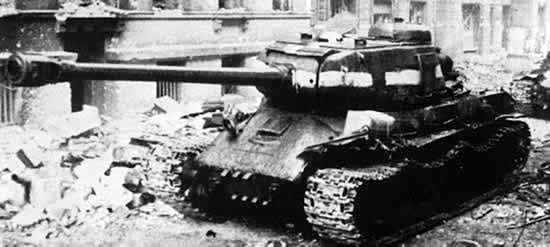
IS-2, Berlin, 1945
The Battle of Berlin saw scores of IS-2s committed to destroying entire buildings thanks to their powerful HE rounds. The assault comprised the 7th separate Guards (104th, 105th and 106th tank regiments), the 11th Heavy Tank Brigade's 334th Regiment, the 351st, 396th, 394th regiments from various units and the 362nd and 399th regiments from the 1st Guards Tank Army, the 347th from the 2nd Guards Tank Army, all part of the 1st Belorussian Front, and the 383rd and 384th regiments of the 3rd Guards Tank Army (1st Ukrainian front). They were tactically arranged in small units of 5 IS-2s supported by a company of assault infantry, including sappers and flame-throwers. The operation lasted until the 2nd of May 1945, with more than 67 IS-2s destroyed in action, mostly by the "Faustniks" (panzerfausts).
Postwar career
The IS-2M was the new standard of modifications, which was applied to nearly all remaining IS-2s after the war. Before this, the IS-2s had been in the first line for 15 years. This set of overhauls spanned from 1954 to 1958. Starting in 1959, some experiments to convert limited numbers of IS-2s into tactical missile mobile launchers gave several turretless versions. The 8K11 and 8K14 missiles were carried and the modified tanks range increased to 300 km (186 mi). Others were converted as ARVs, in two versions, only differing by the position of the commander cupola. IS-2Ms participated in the Soviet-Chinese border crisis, other were stationed on the Kuriles islands and Sakhalin or later turned into bunkers. They remained in active service long enough to participate in the large-scale maneuvers of Odessa in 1982. After this, all remaining IS-2Ms were stored. As of 1995 they were officially put out of commission and were gradually sold for scrap. Perhaps 100 or less are still in storage.The IS-2 also equipped future Warsaw pact nations, starting in 1945 with the Polish, Czech and Hungarian armies. Polish tanks took an active part in the final push on Pomerania in 1945, while the Hungarian ones were committed during the 1956 Revolution. Perhaps 100 or less (exact numbers are evasive) were also sent to the Chinese in 1950. It is not known how many took part in the great North Korean counter-offensive in the summer of 1951. Several were also sent to the North-Vietnamese fighting the French colonial forces. In Korea, according to U.S. data actions, the fighting involved four separate tank regiment manned by Chinese volunteers, each of which had three companies of T-34/85s and one of IS-2s. Eventually, a shipment of IS-2Ms arrived in Cuba in late 1960, but not the following spare parts, prevented by the US blockade during the 1962 crisis. Two regiments of 41 tanks were active but stationed in reserve by Castro, near the sugar factory Australia, and never participated in the "Bay of Pigs" battle. They were all later turned into bunkers for coastal defense.
Unused Design
Nikolai Fedorovich Shashmurin, a well-known tank designer, drew up plans for a possible alternative to the IS-2. Unofficially named the IS-2Sh (Sh = Shashmurin) or simply Shashmurin's IS-2, it was a complete redesign of the IS. It featured a rear-mounted turret carrying the 122mm gun, large single roadwheels and heavily sloped frontal hull armor. The engine was placed in the middle of the hull, with the driver at the bow cut of off from the rest of the crew. Only one drawing is known to exist of this design.
The only known image of the IS-2 "Sh".
IS-2 related links and references
The IS family on WikipediaOn WWIIvehicles.com
On Battlefield.ru
On Flames of War
IS-2 model 1944 specifications |
|
| Dimensions (L-w-h) | 6.2 (9.9 with gun) x 3.10 x 2.73 m (20.34/32.48 x 10.17 x 8.96 ft) |
| Total weight, battle ready | 46 tonnes (90,000 lbs) |
| Crew | 4 (commander, loader, gunner, driver) |
| Propulsion | V2 diesel V12, 600 bhp (450 kW) |
| Speed | 37 km/h (23 mph) |
| Range (road/off road) | 240 km (150 mi) |
| Suspensions | Transverse torsion arms |
| Armament (variable) | 122 mm (4.8 in) D-25T 2xDT 7.62 mm (0.3 in) machine guns DShK 12.7 mm (0.5 in) AA machine gun |
| Armor thickness | 30 to 120 mm (1.18-4.72 in) |
| Production | 3,854 |
Gallery
IS-2 used as target
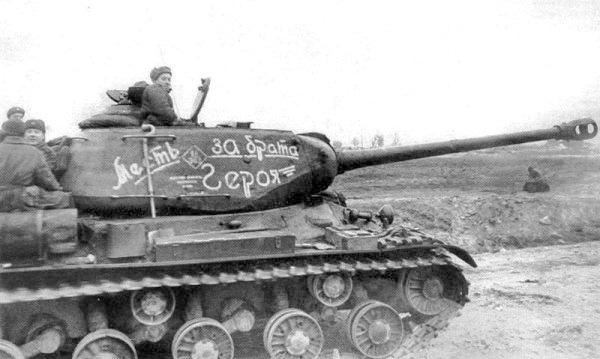
Revenge for the Hero Brother' slogan on the side of the turret
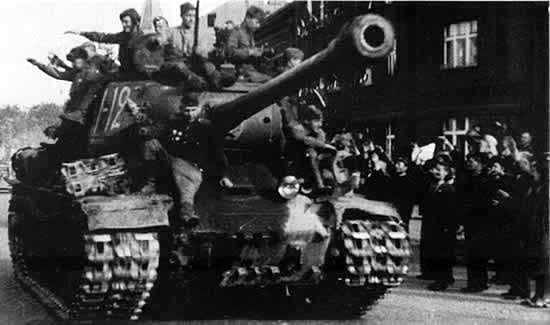
IS-2, Bohemia, Czech Republic, 1945
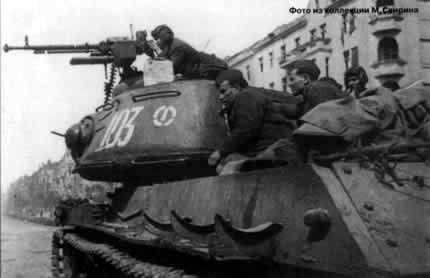
Close view of the DSHK machine gun in action
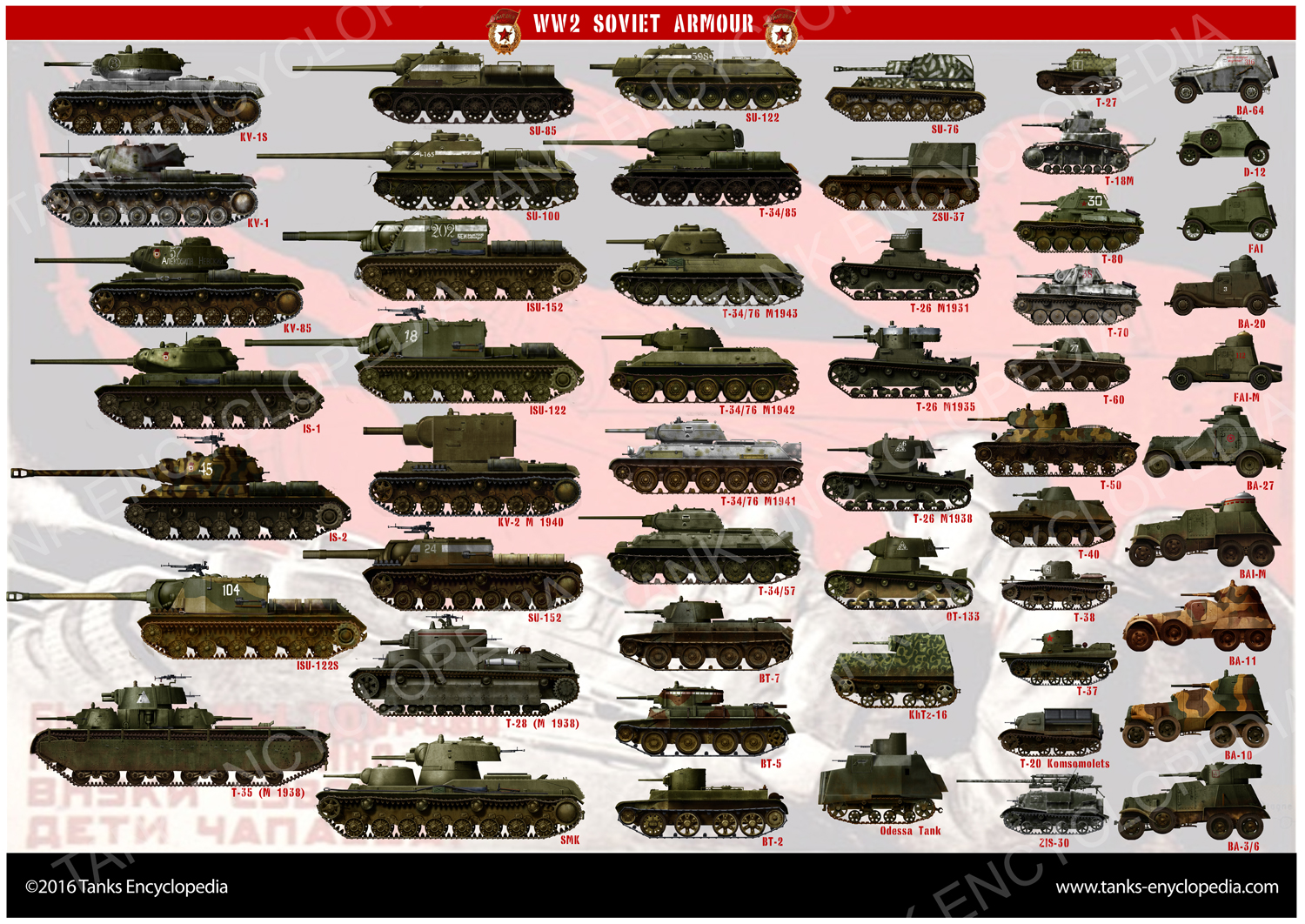
ww2 Soviet Tanks Poster

IS-1 model 1943, for comparison.

IS-2 model 1943, 88th Independent Guards Heavy Tank Regiment, Berlin, April 1945.

IS-2 model 1943, Berlin, April 1945, General Rybalko's 3rd Guards Tank Army.

IS-2 model 1943, winter 1943-44, Vitebsk sector.

Model 1944, 29th Guards Heavy Tank Battalion, Poland, early 1945.

A partially camouflaged IS-2 model 1944 from an unknown Guards Heavy Tank Regiment, late 1944.

Camouflaged IS-2, 4th Guards Tank Army, summer 1944.

IS-2 model 1944 from the 7th Independent Guards Heavy Tank Battalion, Berlin, April 1945. Number 434 was named "Combat Girlfriend" and fought in the southeastern Berlin suburbs as part of Chuykov's 8th Guards Army. They had a polar bear painted over a red star to commemorate their participation in the previous Karelian campaign.

IS-2 model 1944 from an unknown unit, Karelia, 1944.
Artist impression of an IS-2 with a IS-1 turret, quite possibly a marriage made when both tanks suffered damaged, one to the hull, the other to the turret. Inspired by the scale model work of Ulf Andersson, https://www.plasticwarfare.se.

Unknown Guards Independent Unit, Seelow heights, March-April 1945.

Model 1944, partial winter camouflage, Eastern Prussia, February 1945

1st Czechoslovak Tank Brigade, Prague, May 1945.

Polish 4th Heavy Tank Regiment, Germany, April 1945.
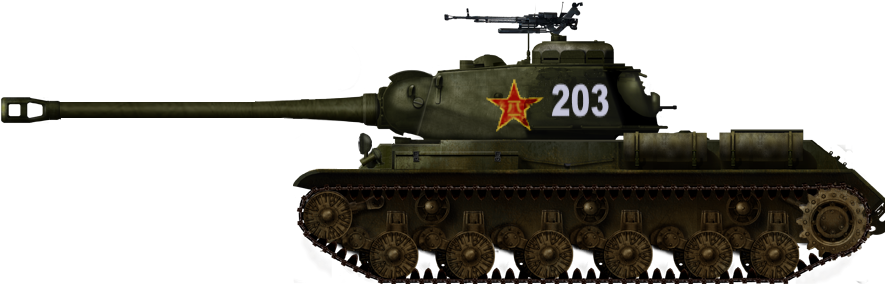
IS-2 of the People's Liberation Army, on parade in Beijing, 1954.

IS-2M, modernized version with stowage bins over tracks and other modifications, 1957.

WW2 Tanks




























WW2 tanks posters

All Tiger tanks liveries.

Panther liveries and variants

WW2 Armour - All tanks











Tanks aces and single tanks series

Find more there

Museums, Movies, Books & Games
The Tanks and Armor in pop culture
Tanks and armored vehicles in general are only really grasped when seen first person: The mass, the scale, it's all there. Explore also the way tanks were covered in the movie industry, in books and in video games.Movies:
Best tanks movie on warhistoryonline.com
On imdb.com
On bestsimilar.com/
miltours.com
liveabout.com/
watchmojo.com
Video Games:
pcgamesn.com
historyhit.com
levvvel.com
vg247.com/best-tank-games
mmobomb.com/
alienwarearena.com

